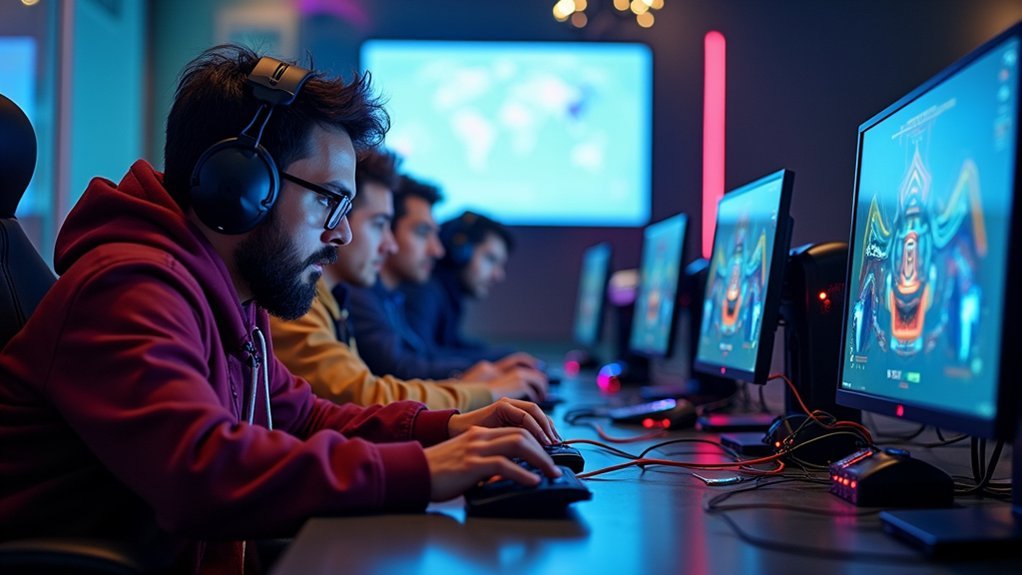You’ll master multiplayer state replication by implementing server authoritative models that validate all player inputs, enhancing RPC calls through selective multicasting and frequency throttling at 10-15 calls per second, enabling movement replication for VR controllers with HMD position synchronization, using delta compression to send only state changes, applying interest management to filter updates by proximity, batching multiple changes into single packets, and combining RPCs with state replication for peak performance. These techniques guarantee seamless synchronization while maintaining bandwidth efficiency and preventing desynchronization issues that could break immersion in your virtual environment.
Server Authoritative Model Implementation for VR Environments

When developing multiplayer VR applications, you’ll need to implement a server authoritative model that places the server in complete control of game state validation and distribution. This approach prevents cheating by validating all player input before processing actions.
You’ll use Remote Procedure Calls to manage critical game events centrally, ensuring consistent gameplay across all clients. Your server must check every movement and interaction before replicating changes to other players.
While this creates security and synchronization benefits, you’ll need latency compensation techniques like client-side prediction to maintain smooth VR experiences.
Client-side prediction becomes essential for overcoming network delays while maintaining the responsive feel that VR users expect.
Pay special attention to replicating immersive elements such as hand and body animations, as these require precise synchronization to preserve the sense of presence that makes VR compelling for all participants.
Remote Procedure Call Optimization in Virtual Reality Applications
Three core principles drive effective RPC optimization in VR applications: selective transmission, delivery reliability, and strategic prioritization.
You’ll want to minimize call frequency by sending RPCs only when necessary, reducing latency that breaks immersion. Implementing reliable delivery methods guarantees synchronized actions across clients, keeping experiences consistent in fast-paced environments.
Use multicast RPCs selectively for efficient event broadcasting to multiple clients simultaneously. This approach reduces per-player overhead considerably.
Prioritize RPCs for critical state changes like player interactions or environmental updates. For less critical updates, you can create a custom event system using alternative techniques.
Make certain you’re profiling RPC performance through in-engine tools to identify bottlenecks. This data-driven approach delivers much better network performance, allowing you to fine-tune synchronization methods effectively.
Movement Replication Configuration for VR Character Controllers

You’ll need to configure VR movement synchronization differently than traditional character controllers since head and body positions must remain perfectly aligned across all clients.
Hand tracking replication requires additional consideration because you’re dealing with multiple tracked points that update at high frequencies, potentially overwhelming your network bandwidth.
Your VR character setup should prioritize head movement accuracy while implementing smart filtering for hand positions to maintain immersion without sacrificing performance.
VR Movement Synchronization
Since VR environments demand precise spatial tracking and seamless multiplayer interaction, configuring movement replication for VR character controllers requires specialized approaches that go beyond traditional game networking.
You’ll need to enable “Replicate Movement” in your VR character controller blueprint, allowing the server to manage player movements across all clients effectively.
Configure “HMD Position” and “HMD Orientation” replication settings to synchronize headset tracking data, ensuring consistent spatial orientation for all players.
Implement networked interpolation systems to smooth positioning updates and reduce jitter over the network.
Use RPCs to trigger specific VR actions like grabbing or throwing objects, with server validation before client execution.
Customize VR input bindings so the server receives and processes inputs consistently, maintaining coherent gameplay across your multiplayer VR environment.
Hand Tracking Replication
While hand tracking replication builds upon the foundational movement systems covered previously, it demands additional configuration to capture and synchronize the intricate movements of players’ hands across your multiplayer VR environment.
You’ll need to enable movement replication for your VR character controller and leverage Unreal Engine’s motion controller components to capture precise hand positions and orientations.
Here’s your implementation approach:
- Configure motion controller components to capture hand data and replicate positions across all connected clients.
- Implement RPCs for specific gestures to trigger real-time interactive events that enhance player engagement.
- Apply optimization techniques like batching updates and limiting replication frequency to maintain performance.
Testing server authority over hand tracking data guarantees consistency and prevents discrepancies across your multiplayer VR experience.
Client-Server Communication Patterns for VR Multiplayer Games
When developing VR multiplayer games, you’ll need to establish robust client-server communication patterns that can handle the unique demands of immersive environments.
Implement a server authoritative model to prevent cheating by validating all critical actions server-side before broadcasting to clients. You’ll rely heavily on Remote Procedure Calls (RPCs) to synchronize player movements and interactions efficiently, managing bandwidth carefully to prevent performance lag.
Server-side validation of critical actions prevents cheating while efficient RPC implementation ensures smooth bandwidth management in VR multiplayer environments.
Use multicast RPCs for simultaneous updates across all connected clients, ensuring consistent experiences when players interact or environmental changes occur.
Implement latency management through client-side prediction and reconciliation techniques to minimize perceived delays between actions and server responses.
Employ delta compression for state synchronization, transmitting only changed data to reduce network overhead and improve overall VR multiplayer performance.
Animation Montage Synchronization Across VR Instances

When you’re building VR multiplayer experiences, you’ll need to synchronize animation montages across all connected instances to maintain visual consistency.
You can achieve this by setting up dedicated RPC functions that trigger animations on the server and broadcast them to every client simultaneously.
This approach guarantees that when one player performs an action like grabbing an object or gesturing, all other players see the same animation playing at the exact same time.
VR Animation RPC Setup
Since VR experiences demand precise timing and seamless player interactions, implementing proper animation montage synchronization becomes critical for maintaining immersion across all connected instances.
You’ll need to create a dedicated RPC function that triggers animations on the server, guaranteeing simultaneous command delivery to all clients. Use multicast replication for your animation RPC to execute seamlessly across all connected instances without requiring individual calls.
Here’s your essential setup approach:
- Configure default slots in your animation blueprint to facilitate smooth playback across different player avatars.
- Minimize RPC call frequency to prevent bandwidth issues and maintain ideal VR performance.
- Test thoroughly with varying player counts to verify animations play correctly without noticeable delays across all VR instances.
This foundation guarantees synchronized, immersive multiplayer VR experiences.
Cross-Instance Montage Broadcasting
As VR instances multiply across your networked session, maintaining synchronized character animations requires a robust cross-instance montage broadcasting system that guarantees every player witnesses identical movements and gestures.
You’ll need to create a dedicated server RPC like “RPC_PlayAnimationMontage” that triggers montages for all connected clients simultaneously. Implement multicast replication to send animation commands from server to all clients at once, reducing latency and preserving synchronization across players’ experiences.
Proper animation blueprint slot management ensures montages play in correct contexts while allowing server RPC overrides.
Limit RPC frequency to prevent bandwidth overload—only broadcast when necessary during specific player actions or events. This approach maintains performance while delivering seamless animation synchronization across your multiplayer VR environment.
Bandwidth Management Strategies for VR State Updates
Although VR applications demand real-time synchronization across multiple users, you’ll face significant bandwidth challenges that can make or break the immersive experience.
You can tackle these challenges through strategic optimization techniques:
- Delta compression – Send only state changes rather than complete data packets, dramatically reducing network load while maintaining accuracy.
- Interest management – Filter updates based on client proximity and relevance, ensuring users receive only necessary information for their virtual location.
- Update batching and prioritization – Group multiple changes into single packets while prioritizing critical data like player positions over less important elements.
Implementing throttling mechanisms lets you control update frequencies, balancing real-time responsiveness with bandwidth limitations.
These strategies work together to create smooth, synchronized VR experiences without overwhelming your network infrastructure.
Performance-Optimized RPC Frequency Control in Virtual Reality
While VR applications require frequent frame updates to maintain immersion, you’ll need to strategically control Remote Procedure Call (RPC) frequency to prevent network bottlenecks from destroying performance.
Limit RPCs to essential user-triggered events rather than continuous updates. Implement throttling mechanisms that cap RPC calls at 10-15 times per second—this maintains responsiveness while dramatically reducing bandwidth consumption.
You should combine RPCs with state replication for ideal results. Send critical updates through RPCs while using state replication for less frequent changes.
Prioritize multicast RPCs for important events to guarantee all clients receive updates simultaneously, preventing desynchronization issues.
Profile your network performance during development to identify RPC bottlenecks. This data helps you refine frequency control and enhance your multiplayer VR experience effectively.
Frequently Asked Questions
How Do Cross-Platform Multiplayer Games Handle State Replication Between Different Devices?
You’ll find that cross-platform games use standardized protocols and data formats to sync game states. They employ authoritative servers, delta compression, and consistent serialization methods ensuring all devices receive identical state updates regardless of platform.
What Happens to State Synchronization When Players Experience Network Disconnections?
When you’re disconnected, games typically freeze your character’s state, queue missed updates, then rapidly sync you back up once you’re reconnected. You’ll experience brief lag spikes during resynchronization.
Can Multiplayer State Replication Work Effectively With Peer-To-Peer Networking Architectures?
You’ll face challenges implementing peer-to-peer state replication since there’s no central authority. You can use consensus algorithms or designate host peers, but you’ll deal with synchronization complexity and potential cheating vulnerabilities.
How Does Latency Compensation Affect Accuracy in Competitive Multiplayer Scenarios?
You’ll face trade-offs between responsiveness and precision when implementing latency compensation. Techniques like lag compensation and rollback improve player experience but can create discrepancies that skilled players exploit competitively.
What Are the Security Implications of Client-Side Prediction in Multiplayer Games?
You’re exposing your game to cheating when clients predict movement and actions locally. Malicious players can manipulate prediction data, sending false positions or impossible moves that servers might accept without proper validation.





Leave a Reply